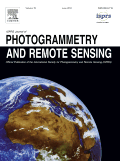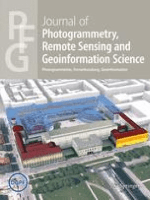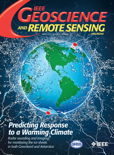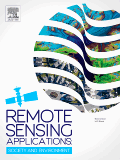
ISPRS JOURNAL OF PHOTOGRAMMETRY AND REMOTE SENSING
Scope & Guideline
Transforming Data into Knowledge in Geospatial Sciences
Introduction
Aims and Scopes
- Remote Sensing Techniques and Applications:
The journal covers a wide range of remote sensing techniques, including satellite, aerial, and UAV-based methods, focusing on their applications in environmental monitoring, urban planning, agriculture, and disaster management. - Photogrammetry Innovations:
Research related to photogrammetry, including 3D modeling, structure from motion, and image processing techniques, is a key focus area, emphasizing advancements in methodology and technology. - Data Fusion and Integration:
The journal emphasizes the integration of various data sources, such as combining optical, radar, and LiDAR data, to enhance the accuracy and richness of geospatial information. - Machine Learning and AI Applications:
There is a strong emphasis on the application of machine learning and artificial intelligence techniques in remote sensing, particularly for classification, change detection, and object recognition. - Environmental and Agricultural Monitoring:
Research focusing on the use of remote sensing for monitoring environmental changes, agricultural practices, and land use dynamics is a significant part of the journal's scope. - Urban Remote Sensing:
The journal addresses urban studies through remote sensing, including urban heat islands, land cover classification, and infrastructure monitoring.
Trending and Emerging
- AI and Machine Learning in Remote Sensing:
There is a significant increase in research focusing on the application of AI and machine learning in remote sensing, particularly for tasks like image classification, change detection, and data fusion. - Multi-Source Data Fusion:
Emerging studies increasingly emphasize the integration of data from multiple sources, such as combining satellite, UAV, and ground-based sensors, to enhance analysis and improve accuracy. - Real-Time Remote Sensing Applications:
Research is trending towards real-time applications of remote sensing data, particularly in environmental monitoring and disaster response, highlighting the need for rapid data processing and analysis. - Urban Remote Sensing and Smart Cities:
The focus on urban applications of remote sensing is growing, with increased interest in monitoring urban dynamics, infrastructure, and environmental impacts in the context of smart city initiatives. - Phenological Studies and Climate Monitoring:
An emerging trend is the use of remote sensing for detailed studies of phenology and climate change impacts, contributing to a better understanding of ecosystem dynamics.
Declining or Waning
- Traditional Photogrammetry:
As new technologies and methodologies emerge, traditional photogrammetry techniques are becoming less emphasized in favor of more advanced methods such as machine learning and AI-driven approaches. - Basic Remote Sensing Algorithms:
The focus on basic algorithms for remote sensing data processing is waning as researchers increasingly adopt complex, data-driven models that leverage deep learning and other advanced techniques. - Single-Sensor Studies:
Research that focuses solely on single-sensor studies is declining, with a growing preference for multi-sensor approaches that provide more comprehensive insights. - Manual Data Processing Techniques:
There is a noticeable reduction in publications discussing manual or semi-automated data processing techniques, as the field moves towards fully automated and AI-driven solutions.
Similar Journals

Science of Remote Sensing
Unlocking the Potential of Remote Sensing TechnologiesScience of Remote Sensing, published by Elsevier, is a premier open-access journal that has been at the forefront of interdisciplinary research since its inception in 2020. With an impressive impact factor and its status in the Q1 quartile category for both Earth and Planetary Sciences and Forestry, this journal effectively caters to a diverse audience, including researchers, professionals, and students interested in the latest developments in remote sensing technologies and their application across varied domains. Located in the Netherlands, the journal provides a collaborative platform for scientific discourse, ensuring that impactful research is easily accessible to the global community. As it converges its focus through to 2024, Science of Remote Sensing continues to promote innovation and excellence, establishing itself as a vital resource for advancing knowledge in both the agricultural and environmental sectors. With a robust ranking (Rank #6 in Forestry and Rank #8 in General Earth and Planetary Sciences), it is well-positioned to contribute significantly to ongoing scientific advancements.

PFG-Journal of Photogrammetry Remote Sensing and Geoinformation Science
Innovating Research for a Sustainable PlanetPFG-Journal of Photogrammetry Remote Sensing and Geoinformation Science, published by Springer International Publishing AG, stands as a prestigious peer-reviewed journal at the intersection of cutting-edge technology and the vital disciplines of Earth and Planetary Sciences, Geography, and Instrumentation. With an impressive impact factor and ranking within the Q1 category, this journal regularly publishes innovative research, methodologies, and case studies that drive advancements in the field. As of its converged years from 2017 to 2024, the journal focuses on the latest trends in photogrammetry, remote sensing, and geoinformation science, providing a crucial platform for researchers, professionals, and students alike. Its open access model ensures that findings are widely accessible, fostering collaboration and knowledge dissemination throughout the global scientific community. Located in Switzerland, geographical and technological diversity is embraced, making the PFG Journal an essential resource for those dedicated to exploring the complexities of our planet and contributing to sustainable development.

Remote Sensing Letters
Elevating Academic Discourse in Earth and Planetary SciencesRemote Sensing Letters, published by Taylor & Francis Ltd, is a distinguished journal that serves a vital role in the fields of Earth and Planetary Sciences as well as Electrical and Electronic Engineering. With an ISSN of 2150-704X and an E-ISSN of 2150-7058, this journal has been disseminating cutting-edge research since its inception in 2010, converging toward a future of innovation and technological advancement scheduled through 2024. The journal is recognized for its impactful scholarship, achieving a Q2 quartile ranking in both its categories as of 2023, highlighting its significance in enhancing academic discourse and applications in remote sensing methodologies. Although it does not operate under an open-access model, it provides access to essential findings that address contemporary challenges in the remote sensing domain. Located in the United Kingdom at 2-4 Park Square, Milton Park, Abingdon, OX14 4RN, Remote Sensing Letters is a crucial resource for researchers, professionals, and students committed to advancing their understanding and application of remote sensing technologies.

IEEE Geoscience and Remote Sensing Magazine
Empowering Research in Earth Sciences and BeyondIEEE Geoscience and Remote Sensing Magazine, published by the esteemed IEEE-Institute of Electrical and Electronics Engineers Inc, serves as a pivotal platform for cutting-edge research in the realms of geoscience, remote sensing, and related disciplines. With an ISSN of 2473-2397 and E-ISSN of 2168-6831, this prestigious magazine has established itself as a leading resource in its field, achieving a Q1 ranking across multiple categories including Computer Science, Earth and Planetary Sciences, and Electrical and Electronic Engineering. Researchers will appreciate its high impact, recognized by impressive Scopus rankings—2nd in Physics and Astronomy, 3rd in Earth Sciences, and 7th in General Computer Science, placing it firmly in the top percentiles globally. Published bimonthly and compatible with various access options, the magazine aims to disseminate innovative solutions and technological advancements, fostering collaboration and knowledge-sharing among professionals, students, and industry stakeholders. As it converges its contributions from 2013 to 2024, IEEE Geoscience and Remote Sensing Magazine continues to significantly influence the scientific community's understanding of the planet and its systems.

Remote Sensing Applications-Society and Environment
Advancing knowledge at the intersection of society and environment.Remote Sensing Applications-Society and Environment, published by Elsevier, stands at the forefront of interdisciplinary research, bridging the fields of remote sensing and environmental science. With an impressive impact factor and recognition within the Q1 quartile in both Computers in Earth Sciences and Geography, Planning and Development, the journal is a vital resource for researchers, professionals, and students committed to advancing our understanding of environmental dynamics through innovative remote sensing technologies. Since its inception in 2015, this journal has cultivated a rich repository of knowledge, addressing pertinent societal and environmental issues, making it a leading source for transformative applications in the field. Accessible and relevant, articles published here not only explore theoretical advancements but also practical implications, ensuring research findings are effectively disseminated to stimulate further inquiries and applications in sustainability and ecological stewardship. The journal's strong Scopus rankings, particularly within its categories, solidify its role as an essential platform for scholarly exchange.

INTERNATIONAL JOURNAL OF REMOTE SENSING
Advancing Knowledge in Remote Sensing for Global ImpactInternational Journal of Remote Sensing, published by Taylor & Francis Ltd, stands at the forefront of Earth and Planetary Sciences, providing a critical platform for disseminating pioneering research since its inception in 1980. With an impressive ranking of #25 out of 195 in general Earth and Planetary Sciences and a notable 87th percentile on Scopus, this journal is recognized for its high-quality contributions that span diverse topics including satellite imagery analysis, geospatial technologies, and environmental monitoring. As a Q1 journal in its field for 2023, it offers invaluable insights and methodologies that are essential for researchers, professionals, and students alike. Although not Open Access, the journal facilitates a comprehensive understanding of remote sensing sciences, ensuring that the scholarly community remains updated with the latest advancements, trends, and applications that impact global challenges.

Geo-Spatial Information Science
Innovating Insights in Spatial Data AnalysisGeo-Spatial Information Science, published by TAYLOR & FRANCIS LTD, is a premier open-access journal that has been at the forefront of disseminating cutting-edge research since its inception in 1998. With an ISSN of 1009-5020 and an E-ISSN of 1993-5153, this journal plays a pivotal role in the fields of Computers in Earth Sciences and Geography, Planning and Development, achieving a prestigious Q1 ranking in both categories as of 2023. Its exemplary Scopus rankings highlight its relevance within the social sciences and earth sciences, placing it among the top echelons of its field, with a 95th and 93rd percentile respectively. The journal aims to bridge the gap between innovative geospatial technologies and their applications in real-world scenarios, fostering interdisciplinary collaboration and advancing the global understanding of spatial data analysis. Based in the United Kingdom, Geo-Spatial Information Science invites researchers, professionals, and students to contribute and access research that shapes the future of geo-spatial sciences, all while adhering to open access principles that ensure broad dissemination and engagement with the broader academic community.

Drones, published by MDPI in Switzerland, is a leading open-access journal dedicated to advancing research in the dynamic field of drone technology and applications. Since its inception in 2017, this journal has quickly established itself as a vital source of scholarly content, boasting a Q1 ranking in Aerospace Engineering and strong placements in Artificial Intelligence, Computer Science Applications, Control and Systems Engineering, and Information Systems. The journal aims to foster discourse and innovation around drone usage across various sectors, including environmental monitoring, logistics, and advanced manufacturing. With an impressive Scopus ranking, including a top 30 position in Aerospace Engineering, Drones continues to draw contributions from a diverse array of researchers, professionals, and students, thereby enriching the academic dialogue surrounding this transformative technology. As an open-access journal, it ensures that research is widely accessible, promoting transparency and collaboration within the international research community.

Geocarto International
Advancing Knowledge at the Intersection of Geography and PlanningGeocarto International is a premier peer-reviewed journal published by Taylor & Francis Ltd that focuses on the intersection of geography, planning, and environmental science, offering valuable insights into emerging research trends and methodologies within these fields. With an impressive impact factor, the journal is consistently recognized for its contributions, ranked in the Q1 category for Geography, Planning, and Development as well as Q2 in Water Science and Technology as of 2023. Geocarto International not only showcases high-quality research articles but also embraces Open Access publishing since 2023, promoting accessibility and fostering a global dialogue among researchers, professionals, and students. Spanning over three decades from its inception in 1986 to 2024, the journal continues to serve as an essential platform for disseminating knowledge, advancing scholarly communication, and addressing crucial environmental challenges across the United Kingdom and beyond. Explore the latest advancements and contribute to the dynamic discussions shaping the future of geography and environmental sciences through Geocarto International.

South African Journal of Geomatics
Elevating the Discourse in Geographic SciencesSouth African Journal of Geomatics is a pivotal platform dedicated to the advancement of geomatics, focusing on the dynamic intersection of geographic information science, surveying, and mapping technologies. Published by CONSAS CONFERENCE, the journal serves as a crucial resource for researchers, professionals, and students in the geomatics field, providing insightful, peer-reviewed articles that explore contemporary challenges and innovations. Operating under an open-access model, the journal ensures the wide dissemination of knowledge, promoting collaboration and scholarly exchange among the global geomatics community. With a commitment to enhancing the visibility of significant research and fostering academic discourse, the South African Journal of Geomatics plays a vital role in contributing to the development of this essential discipline in South Africa and beyond.